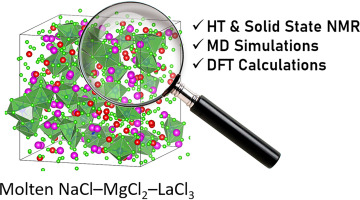Ask for a reprint
email :
* Give your email
2025
ACL
|
W-J.Ng, A.Rakhmatullin, K.Goloviznina, M.Salanne, C.Bessada, 'Structural dynamics of molten NaCl–MgCl2–LaCl3: A proxy for molten chloride fast reactor fuels', J. Nucl. Mater. 616 156056 (2025) doi:10.1016/j.jnucmat.2025.156056
Chloride salts have emerged as the leading candidate fuel for the new generation of molten salt reactors, particularly molten chloride fast reactors (MCFRs). In France, the ARAMIS-A reactor design is exploring the use of NaCl–MgCl2–PuCl3–AmCl3 as fuel for an actinide-burner reactor. However, literature on the structural dynamics of molten chloride fuel salts remains limited, restricting the accurate modelling of fuel performance and behaviour. In this study, we fill this gap by performing in-situ high-temperature nuclear magnetic resonance (HT-NMR) experiments on NaCl–MgCl2–LaCl3, as a surrogate to the (Pu,Am)Cl3 fuel, to investigate the local structural chemistry of molten chloride salts. By complementing our experimental findings with solid-state nuclear magnetic resonance (SS-NMR) measurements, classical molecular dynamics (MD) simulations and density functional theory (DFT) calculations, we elucidate the complex structural interactions in molten chloride systems, such as lanthanide network formation and chlorine bridging, and illustrate how these interactions vary with temperature and fuel composition. Our results establish a clear relationship between NMR chemical shifts and coordination numbers in molten salts, offering critical insights into the local structural environments that influence the behaviour of actinide-based fuels in molten salt reactors.
|

|